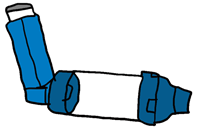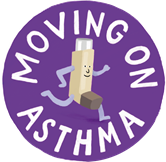Asthma is a condition that affects the lungs. It affects the airways – the tubes that carry air in and out of the body. The airways get inflamed and produce mucus. This makes the airways tight and narrow. Asthma causes:

Asthma sufferers will often find symptoms are made worse by different triggers. This might be smoke, allergies, viruses or cold air.
People with asthma may have times when their symptoms are under control, but a trigger may cause a flare up. Asthma can have other symptoms too, so it is not always easy to diagnose.
What is a Wheeze?
A wheeze is a whistling or squeaking noise mostly heard on an outward breath. It is a sign that, for some reason, the airways are inflamed and narrower than usual.
A wheeze is one of the symptoms of asthma – but a wheeze does not always mean asthma. Most often wheeze goes away after a person recovers from a short term illness.
wheeze is one of the symptoms of asthma – but a wheeze does not always mean asthma. Most often wheeze goes away after a person recovers from a short term illness.
A wheeze is often heard when we have a bad cold and cough. This is known as a ‘viral wheeze’. Some children will get a wheeze every time they have a cold but in between times breathe easily.
Sometimes children may be prescribed inhalers to help with the wheeze, but will not need to use them when they are otherwise well.
When children have asthma, the wheeze may be present at other times. This might be when they are exercising or when they come across a ‘trigger’ for their asthma symptoms – like an allergy.
How is Asthma Diagnosed?
If you have any worries that your child has symptoms similar to asthma you should discuss this with a doctor. Doctors need to decide if your child has asthma or if they have symptoms such as a wheeze for other reasons. It is not always possible to decide this straight away and a definite diagnosis of asthma can take a while. Your child will be treated for their symptoms in the meantime.
The doctor will want to know about the symptoms and see what the risks are for your child having asthma. There are some things that increase the risk of asthma;
There is not a definite way of being sure a young baby or child has asthma and before the age of five it is not possible to give a definite diagnosis. Doctors will want to be sure the symptoms are not caused by something else. They will check if a baby or child has ongoing symptoms of asthma, as well as if they have any of the risk factors above.
The health team are likely to try asthma treatments to see if they help and if they do, they will be prescribed for your child.
About 40% of children who wheeze and have other symptoms when they are little, will eventually be diagnosed with asthma – others will grow out of it.
Asthma Attacks
Asthma attacks can happen for a number of reasons. They can be caused because of contact with a ‘trigger’ like pollen or animal fur. It may be because of a viral illness, like a cold making it worse. Or it could be because asthma treatment plans haven’t been followed.
Often there will have been a change in asthma symptoms on the run up to an attack. If you notice this seeing your GP or nurse may help to stop a bad attack happening.
If you are worried that your child's symptoms are getting worse, you may notice that:
What to Do
You should first:
If things don’t get better, or you feel worried at any time, you can ring 111 for advice.
When to Get More Help?
Call 999 for an ambulance if:
Never be frightened of asking for help in an emergency.
If Your Child is Being Treated for Asthma
Having a child with asthma is a worry for parents, and as children get older they may worry about their own health too.
Asthma is a common condition. It can be serious if not properly looked after. It is important that you follow the advice and treatment given to you by health professionals to keep it as well controlled as possible.
Many people live with asthma with few problems most of the time.
Living with Asthma
If your child has been diagnosed with asthma you may be worried about how this might impact on their day to day life. There are ways you can help keep asthma symptoms under control as much as possible:
Inhalers and Spacers
Check Ups
Environment
Using an Inhaler
Babies and children do get used to using inhalers but there will be times when they are not keen, for all sorts of reasons. It is so important that they take their ‘preventer inhaler, as instructed, every day.
When they have symptoms they need to use their ‘reliever inhaler’ to help them breathe easily again. Hopefully giving them their inhalers will not be a battle but on occasion it may be – it is still important you continue to try.
If using the inhaler is a regular problem, seek advice from your doctor or asthma nurse.
Using a Spacer

Other Things to Remember
Talk to School
Nursery or School need to know if your child is given a diagnosis of asthma. This will allow them to act quickly if your child has symptoms at school.
If your child seems wheezy with their cough or cold, but are usually well, you can help them feel better at home.
 Having you close by will make them feel safe, maybe you could snuggle up together.
Having you close by will make them feel safe, maybe you could snuggle up together.MySpira App for 6-13 Year Olds
The MySpira app is designed to support children and young people with diagnosed asthma to understand all the things they need to know about their condition and encourage good inhaler technique.
It is best suited for six to 13-year-olds and includes eight fun modules. The app combines augmented reality and gameplay to offer the very best asthma education.
The app is validated and safe, and has been developed with close assistance from asthma specialists.
How to Download
Child Asthma Action Plan
This colourful ‘My Asthma Plan’ is designed especially for children age from six to 11.
Fill it in with their GP or asthma nurse. It lists the medicines your child needs to take every day to stay well, what to do if their asthma gets worse, and what to do in an asthma attack.
Older Child (12+) Asthma Action Plan
This plan is designed for adults and children age 12 and over.
Fill it in with your GP or asthma nurse. It lists the medicines you need to take every day to stay well, what to do if your asthma gets worse, and what to do in an asthma attack.
You can contact the Healthy Child Programme by calling Just One Number on 0300 300 0123 or texting Parentline on 07520 631590. Our opening hours are 8am-6pm Monday-Friday (excluding bank holidays) and 9am-1pm on Saturdays.
If you are 11-19 you can text ChatHealth on 07480 635060 for confidential advice from one of our team.
Boloh - Are you are a Black, Asian or Minority Ethnic parent wanting to know more about chest infections? The Boloh helpline can help provide you with advice and guidance on what to do if your child has a chest infection.
Call 0800 151 2605 or visit https://helpline.barnardos.org.uk
They can provide a service in English, Punjabi, Mirpuri, Polish, Luganda, Ruyankole, Rukiga, Rutooro and Kinyarwanda. Interpreters can also be provided for other languages.
If you have decided to keep smoke free around your child - which is especially important for children with Asthma. You can contact Smokefree Norfolk for help and advice.
The Lullaby Trust - Baby Check App- This app has simple checks that you can do if your baby is ill and helps you think about whether they need to see a doctor or health professional.
app has simple checks that you can do if your baby is ill and helps you think about whether they need to see a doctor or health professional.
You can speak to other Norfolk parents and carers by clicking our online community forum below.
Moving On Asthma
On Asthma
A new resource for young people living with asthma.
This website helps young people develop those essential self-management skills and helps them to learn to access healthcare independently one video at a time. From what is asthma to ordering prescriptions, they have it covered.
A free online course about asthma for parents/carers of children and young people with diagnosed asthma. The course covers: